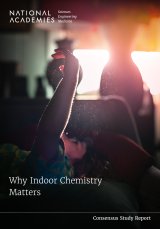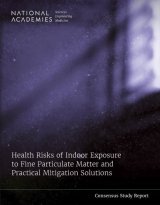Indoor Air Quality Science
On this page:
- Emerging Science on Indoor Chemistry – A Consensus Study
- Research Activities on Indoor Particulate Matter
- Microbiome Reports from the National Academy of Science, Engineering and Medicine
On other pages:
Emerging Science on Indoor Chemistry – A Consensus Study

The National Academies of Sciences, Engineering, and Medicine (NASEM) was tasked by EPA, the Centers for Disease Control and Prevention (CDC), the National Institute of Environmental Health Sciences (NIEHS), and the Alfred P. Sloan Foundation to conduct a study on Emerging Science on Indoor Chemistry. NASEM convened an ad hoc committee of scientific experts and leaders to consider the state-of-the science regarding chemicals in indoor air. Specifically, the committee focused on:
- New findings about previously under-reported chemical species, chemical reactions, and sources of chemicals, as well as the distribution of chemicals; and
- How indoor chemistry findings fit into context of what is already known about the link between chemical exposure, air quality, and human health.
The resulting consensus study report, Why Indoor Chemistry Matters, is available to download for free from the National Academies Press website.
More information, including recordings from the study’s information gathering workshop, report highlights and summaries, and an infographic can be found on the study website.
The Clean Air Act Advisory Committee has advised EPA on priority recommendations from this NASEM study.
Research Activities on Indoor PM
Health Risks of Indoor Exposures to Fine Particulate Matter and Practical Mitigation Solutions

The National Academies of Sciences, Engineering, and Medicine (NASEM) was tasked by EPA to conduct a study on the Health Risks of Indoor Exposures to Fine Particulate Matter and Practical Mitigation Solutions. NASEM convened an expert committee to consider the state-of-the-science on the health risks of exposure to fine particulate matter (PM2.5) indoors and engineering solutions and interventions to reduce those risks, including in residential settings.
The committee’s resulting consensus study report, Health Risks of Indoor Exposure to Fine Particulate Matter and Practical Mitigation Solutions, contains findings and recommendations regarding the key implications of the scientific research for public health, and where additional research will be most critical to understanding indoor exposure to PM2.5 and the effectiveness of interventions.
More information can be found on the consensus study website or by contacting the NASEM by email at [email protected].
Indoor Exposure to Fine Particulate Matter and Practical Mitigation Approaches – Proceedings of a Workshop

NASEM was tasked by EPA to conduct a workshop on Indoor Exposure to Fine Particulate Matter and Practical Mitigation Approaches in April 2021. The workshop addressed the state-of the-science on exposure to PM2.5 indoors, its health impacts, and engineering approaches and interventions to reduce exposure risks, including practical mitigation solutions, in residential settings. The workshop featured invited presentations and panel discussions on these topics. A summary of the workshop was published in Indoor Exposure to Fine Particulate Matter and Practical Mitigation Approaches: Proceedings of a Workshop, which is available to download for free from the National Academies Press website.
The workshop sought to identify opportunities for advancing research by addressing methodological and technological barriers and enhancing coordination and collaboration between the science, medical, and engineering communities.
More information, including recordings from the workshop, can be found on the workshop website or by contacting the NASEM by email at [email protected].
Evaluating the Health Risks of Indoor Exposure to Particulate Matter, Activities Conducted by the National Academies of Science, Engineering, and Medicine Activities

The National Academies of Sciences, Engineering, and Medicine (NASEM) was tasked by EPA to convene a public workshop on February 10-11, 2016, to discuss the state of the science on the health effects of indoor exposure to particulate matter and any associated health impacts. Findings from the workshop are available in the published workshop summary, Health Risks of Indoor Exposure to Particulate Matter. Topics discussed included:
- Sources of indoor particulate matter.
- Particulate dynamics and chemistry.
- Exposure levels and characterization.
- Exposure mitigation.
- Identified and emerging health concerns.
- Interventions and risk communication.
Materials from the workshop are available at the links below:
- Welcome, Workshop Goals, and Introductions - William Nazaroff, Ph.D., Chair
- Sponsor Remarks - David Rowson, U.S. Environmental Protection Agency
- Workshop Summary Report, entitled, Health Risks of Indoor Exposure to Particulate Matter, was released on July 6, 2016.
- Health Risks of Indoor Exposure to Particulate Matter – Summary of a National Academies Workshop and Communicating the Health Risks of Indoor Exposure to Particulate Matter – Challenges and Opportunities presented by David Butler, Guru Madhavan, and George Gray (January 31, 2018)
Microbiome Reports from the National Academy of Science, Engineering and Medicine (NASEM)
Microbiomes of the Built Environment

The National Academies of Science, Engineering, and Medicine (NASEM) released a report co-sponsored by the EPA in 2017, Microbiomes of the Built Environment, that examines microbial communities in built environments and the impacts of these microbial communities on health. The study describes the state of scientific research and proposes a research agenda with areas of focus to move the field from research to application.
- Consensus Study Report (the PDF can be downloaded for free)
- Summary of the Report
Report Brief for:
- Building Professionals
- Public Health Professionals,
- Microbial Ecologists, Molecular Biologists, and other stakeholders in basic sciences.
Visit the NASEM for additional information.
Environmental Chemicals, the Human Microbiome, and Health Risk: A Research Strategy

(NASEM) released a report, co-sponsored by the EPA in 2017, Environmental Chemicals, the Human Microbiome, and Health Risk: A Research Strategy, that proposes a research strategy to advance understanding of the interactions between environmental chemicals and the human microbiome and the implications of those interactions on human health risk. The report also highlights key aspects of the human microbiome and its relation to health, describes potential interactions between environmental chemicals and the human microbiome, reviews the risk-assessment framework and reasons for incorporating the proposed research, describes methods for studying the microbiome, and identifies barriers for research and opportunities for collaboration.
- Consensus Study Report (the PDF can be downloaded for free)
